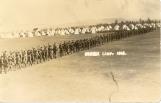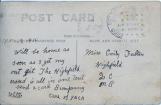1
Dinner in the Tent linesCirca 1916
Sussex, New Brunswick, Canada
 Credits:
Credits:New Brunswick Provincial Archives - P148-24 / Four men holding tins of food; tents in background
Annual Report, Department of Militia and Defence of the Dominion of Canada
2
Medical Corp Memberscirca 1910
Sussex, New Brunswick, Canada
 Credits:
Credits:New Brunswick Provincial Archives - P210-3098 / Camp Sussex Medical Staff
Annual Report, Department of Militia and Defence of the Dominion of Canada
3
Officers Quarters, 104th Overseas Battalioncirca 1915
Sussex, New Brunswick, Canada
 Credits:
Credits:Association of the 8th Canadian Hussars (Princess Louise's) Inc
Annual Report, Department of Militia and Defence of the Dominion of Canada
Ganong, AT, A Historical Outline of the Regiment
4
Postcard 55 Infantry Battalion on parade - Camp Sussex12 November 1915
Sussex, New Brunswick, Canada
 Credits:
Credits:Sandra Muir-Russell
Annual Report, Department of Militia and Defence of the Dominion of Canada
Ganong, AT, A Historical Outline of the Regiment
A Historical Outline, The New Brunswick Rangers
5
Postcard 55 Infantry Battalion on parade - Camp Sussex (Reverse side)12 November 1915
Sussex, New Brunswick, Canada
 Credits:
Credits:Sandra Muir-Russell
Annual Report, Department of Militia and Defence of the Dominion of Canada
6
Overseas Reinforcements, Sussex Train StationCirca 1915
Sussex, New Brunswick, Canada
 Credits:
Credits:Gary Bowser
Annual Report, Department of Militia and Defence of the Dominion of Canada
Ganong, AT, A Historical Outline of the Regiment
Crook and Marteinson, A Pictorial History of the 8th Canadian Hussars (Princess Louise's)
7
At the onset of World War I, Camp Sussex was quickly established as a training center for the necessary units required overseas. All militia training was suspended and numbered battalions were established, much to the chagrin of the long established militia units who had been in existence since the early 1800's. The earliest units formed were infantry units who quickly absorbed volunteers from the local militia battalions. Some of the first men were from H Company, 74th Battalion who left on 20 August 1914 to go overseas. Key units who were established or trained in Camp Sussex included the 40th Battalion (Moncton) the 55th Battalion (New Brunswick and Prince Edward Island), the 64th Battalion (Moncton), the 104th Battalion (Sussex) and later the 1st NB Depot Battalion. Each of these units averaged 1100 men but never saw action in France as a formed unit but were absorbed by other line units after landing in France.As manpower and these formed battalions were brought up to strength and moved overseas, it was necessary to establish schools to train the necessary reinforcements required to maintain manpower levels overseas. This led to the establishment of the 1st New Brunswick Depot Battalion at Camp Sussex. This depot was tasked with training and holding all recruits from around the province until they could be equipped, provided basic military skills and then shipped forward to units overseas to fill the tremendous numbers of vacancies created by the high numbers of casualties being experienced on the battlefields of Europe. The numbers of recruits at these camps varied and included all drafted members of the forces after the passing of the Military Service Act of 1917.
Following the Armistice, these centers were used a demobilization centers for returning soldiers from the Overseas Canadian Corp.